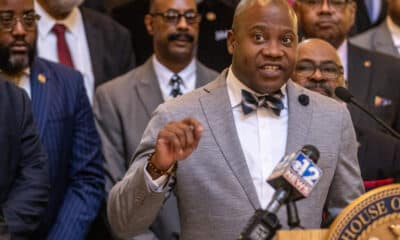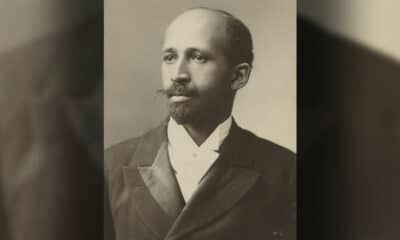Kaiser Health News
$50 Billion in Opioid Settlement Cash Is on the Way. We’re Tracking How It’s Spent.
by Aneri Pattani
Thu, 30 Mar 2023 09:00:00 +0000
More than $50 billion in settlement funds is being delivered to thousands of state and local governments from companies accused of flooding their communities with opioid painkillers that have left millions addicted or dead.
That’s an enormous amount of money — double NASA’s budget and five times the revenue of an NBA season.
But how that massive windfall is being deployed and how future dollars will be spent seem to be shrouded in mystery. Reporting requirements are scant, and documents filed so far are often so vague as to be useless.
Most of the settlements stipulate that states must spend at least 85% of the money they will receive over the next 15 years on addiction treatment and prevention. But defining those concepts depends on stakeholders’ views — and state politics. To some, it might mean opening more treatment sites. To others, buying police cruisers.
Those affected by the opioid epidemic and those working to fight it have an array of ideas: To Marianne Sinisi, who lost her 26-year-old son, Shawn, to overdose in western Pennsylvania, the settlement funds are “blood money” that she hopes can spare other parents similar grief. To Steve Alsum, who works with people who use drugs in Grand Rapids, Michigan, it’s a chance to finally reach all those in need. And to David Garbark, who is in recovery from opioid addiction, it’s a way to give others in his eastern North Carolina community a second chance, too.
Spending the money effectively and equitably is a tall order, given the persistence and complexity of addiction, which affects individuals and communities, and is the topic of heated debates in scientific research, social services, politics, criminal justice, and even at kitchen tables.
What’s more, many states are not being transparent about where the funds are going and who will benefit. An investigation by KHN and Christine Minhee, founder of OpioidSettlementTracker.com, concluded only 12 states have committed to detailed public reporting of all their spending.
The analysis involved scouring hundreds of legal documents, laws, and public statements to determine how each state is divvying up its settlement money among state agencies, city and county governments, and councils that oversee dedicated trusts. The next step was to determine the level and detail of public reporting required. The finding: Few states promise to report in ways that are accessible to the average person, and many are silent on the issue of transparency altogether.
More than $3 billion has gone out to state and local governments so far. KHN will be following how that cash — and the billions set to arrive in coming years — is used.
Per most of the settlements, governments are required to report only on the 15% of the money that can be used for things unrelated to the epidemic, like offsetting budget shortfalls or fixing old roads. As of March 28, only three states and counties had filed such reports. Although they listed dollar amounts, none said precisely how the money was spent.
State and local governments can enact more rigorous reporting protocols — for example, requiring a publicly available list of every place that receives money and for what purpose — but few have so far.
Loading…
Left in the Dark
More than 250,000 Americans have died of overdoses from prescription opioids, which were aggressively promoted as painkillers and distributed by a host of health care companies, including Johnson & Johnson, AmerisourceBergen, McKesson, and Walmart. The settlements are meant to compensate and remediate the effects of that corporate behavior.
But many people whose lives have been upended are again feeling traumatized.
Sinisi said she and other parents who’ve lost kids to addiction have been left in the dark or, worse, treated like nuisances by officials in charge of the money.
“They want to look at you as this angry parent who lost a child,” she said, “rather than a concerned citizen who wants to see a difference made for other mothers, fathers, and their children.”
In Michigan, even the state’s Opioid Advisory Commission, which is tasked with evaluating the use of settlement money, has struggled to track the cash.
For six months after the state legislature allotted $39 million of settlement funds to the health department last summer, little information was made public about how that money would be spent. No news releases. No way for organizations to apply for funds.
“We can’t really identify the impact of those dollars if we don’t know how they’re being used,” said Dr. Cara Poland, the commission’s chair and an addiction-medicine doctor.
With scant oversight nationwide, many people fear dollars may flow to efforts that research has proven mostly useless but jibe with the local political bent, like arresting people who use drugs, expanding jails, and favoring abstinence-only recovery over medications. They may go to the loudest bidder, with companies promising to find the next groundbreaking treatment and rehab facilities — some with shoddy track records — eyeing the cash.
Not to mention concerns that money will flow to activities that have little to nothing to do with opioid treatment: building new stadiums or public schools. Back in the ’90s, these day-to-day budget priorities consumed most of what states won from cigarette companies in the national tobacco settlement, leaving little for anti-smoking programs.
The opioid settlement funds will be different, say state attorneys general who fought for them. In addition to requiring at least 85% of the money be used on opioid-related expenses, most agreements include a list of suggested interventions like increasing addiction treatment for the uninsured and expanding recovery housing.
“We wanted to give states flexibility on what approaches they wanted to adopt,” while ensuring money didn’t go to “provide corporate tax relief” as the tobacco dollars did, said North Carolina Attorney General Josh Stein, who led negotiations for the national settlements.
But enforcement of the 85% standard is, oddly, left to the companies that paid out the money. They are unlikely to be vigilant, legal experts say. The money is committed already and, for many of these multibillion-dollar companies, the settlements are chump change. For example, Johnson & Johnson is set to pay $5 billion over nine years, but the company reported sales of nearly $95 billion in the past year alone.
An Emerging Picture
As the checks start to trickle in, a handful of states are committed to transparency while others seem to be falling short. Missouri has promised to report all its spending in online reports so that anyone can see who receives money, how much, and for what programs. New Hampshire already has posted reports online, and Colorado has created a public dashboard to track how funds are used.
Other states, like Nevada, have taken a middle-of-the-road approach, requiring that recipients report to the legislature or another oversight body, but not ensuring the reports will go public. Some states require audits but don’t promise to list specific expenses. And others allow the public to request records but won’t provide them automatically.
Then there are states hit hard by the opioid epidemic like Michigan and Ohio, where problems with transparency are already emerging. Each state is expecting to receive at least $1 billion.
When Poland, of Michigan’s Opioid Advisory Commission, realized she was getting little information on how the state’s funds were being spent, her commission decided to use its first annual report — published this month — to demand better. “Timely and transparent reporting” to the public is “an ethical responsibility,” it said, calling on lawmakers to enact greater oversight for settlement cash recipients and create a public dashboard to track spending.
KHN interviewed nearly a dozen people and filed a public records request to uncover how the state health department is spending the initial settlement funds allocation of $39 million.
A budget document obtained by KHN shows that as of Jan. 9, the Michigan Department of Health and Human Services had contracted $3.9 million in settlement funds to 35 grantees. Most are local health departments or syringe service programs that the state health department has previously funded.
An additional $27 million is set aside for particular interventions, such as growing the addiction treatment workforce, expanding recovery housing, and mitigating the harms of opioid use with medications like naloxone.
And, after KHN’s inquiries, the department released a statement that listed similar priorities.
Those initiatives make sense to Jonathan Stoltman, director of the Michigan-based Opioid Policy Institute, which researches stigma and digital privacy in addiction treatment. But he would have liked to have known about them in advance and to have had a clear process laid out for groups to apply for the funds. Otherwise, organizations that are well positioned to use the money to help those most in need may miss a once-in-a-lifetime chance to scale up their work and save lives.
Last summer, when Stoltman inquired about applying for the funds, the health department told him to submit a “high level proposal” to “share around,” according to emails reviewed by KHN.
“Anything that is backdoor scares me,” said Stoltman. “I got lucky that I found who to talk to, even if it didn’t go anywhere.”
Steve Alsum, executive director of the Grand Rapids Red Project, which was awarded about $266,000 to improve the health of people who use drugs, said he expected the state to have an application process with scoring criteria to explain why certain groups were chosen. But, he said, “it hasn’t been clear who is making the decision and how it’s made.”
Jared Welehodsky, who leads the department’s efforts related to the settlement, said it is in the process of releasing several competitive grant applications for the bulk of the money. That didn’t happen sooner because most payments didn’t arrive until the end of 2022 and “we didn’t want to comment on how the money was going out when we didn’t have money to go out,” he said.
Talk of Keeping the Public Out
In Newark, Ohio, Linda Mossholder, 75, has been inquiring about the settlement dollars at City Council meetings since last summer. As a volunteer with Newark Homeless Outreach, which serves weekly free lunches, she encounters many people who use drugs and wants to see the money help them.
The proud owner of a T-shirt that reads, “Your first mistake is thinking I’m just an old lady,” Mossholder has followed up with emails, voicemails, and public records requests. But she hasn’t gotten a clear answer about how the city plans to use the nearly $50,000 it’s already received.
In January, Mossholder said, the city’s director of public service finally told her the plan was to allocate settlement cash to first responders for naloxone. But when KHN filed public records requests to confirm, City Auditor Ryan Bubb wrote, “No funds have been allocated or spent.”
Meanwhile, in northeastern Ohio, a regional board that will control millions of settlement dollars spent a February meeting discussing whether the public should be allowed to access meeting recordings at all.
“I wouldn’t open it up to the public, honestly,” said Judy Moran, a board member who represents Eastlake, according to a recording of the meeting obtained by KHN. Other board members asked if their gatherings were subject to the state’s open-meeting laws.
Moran later told KHN, “Of course the public has a right to know how these funds are disbursed,” but she said she worried recordings would allow people to take words “out of context.”
In Ohio at least, that may not be a choice for much longer.
A lawsuit brought by Harm Reduction Ohio to open the meetings of a separate board — the OneOhio Recovery Foundation, which oversees the lion’s share of the state’s expected $1 billion — is working its way through the courts. A local judge this month rejected the foundation’s request to dismiss the lawsuit, writing that “the public deserves transparency.”
But OneOhio spokesperson Connie Luck said the foundation is a “private, nonprofit organization, and not a government agency.” It has so far allowed public attendance at meetings, but has said it is not required to do so.
The final ruling in this lawsuit, which is the first of its kind on opioid settlement funds, will set a precedent for the public’s right to information nationally.
In some parts of the country, the prospect of dollars to treat a long-underfunded epidemic brings hope, said Tricia Christensen, who works at a nonprofit tracking settlement funds across Appalachia. When people know what’s happening, it not only deters misuse but can reveal surprising successes, she said.
That knowledge is empowering.
“These funds are the cavalry coming in. You’re finally getting relief after suffering alone for so long,” said Crystal Glass, of southwestern Virginia, who is in recovery from opioid and meth use and now works as a peer recovery specialist.
She hopes officials will involve people affected by addiction in their decisions.
As she put it: Transparency “is letting everyone — I mean everyone — know they can be part of this.”
KHN’s Colleen DeGuzman and Megan Kalata contributed to this report.
By: Aneri Pattani
Title: $50 Billion in Opioid Settlement Cash Is on the Way. We’re Tracking How It’s Spent.
Sourced From: khn.org/news/article/opioid-drugmakers-settlement-funds-50-billion-dollars-khn-investigation-payback/
Published Date: Thu, 30 Mar 2023 09:00:00 +0000
Kaiser Health News
US Judge Names Receiver To Take Over California Prisons’ Mental Health Program
SACRAMENTO, Calif. — A judge has initiated a federal court takeover of California’s troubled prison mental health system by naming the former head of the Federal Bureau of Prisons to serve as receiver, giving her four months to craft a plan to provide adequate care for tens of thousands of prisoners with serious mental illness.
Senior U.S. District Judge Kimberly Mueller issued her order March 19, identifying Colette Peters as the nominated receiver. Peters, who was Oregon’s first female corrections director and known as a reformer, ran the scandal-plagued federal prison system for 30 months until President Donald Trump took office in January. During her tenure, she closed a women’s prison in Dublin, east of Oakland, that had become known as the “rape club.”
Michael Bien, who represents prisoners with mental illness in the long-running prison lawsuit, said Peters is a good choice. Bien said Peters’ time in Oregon and Washington, D.C., showed that she “kind of buys into the fact that there are things we can do better in the American system.”
“We took strong objection to many things that happened under her tenure at the BOP, but I do think that this is a different job and she’s capable of doing it,” said Bien, whose firm also represents women who were housed at the shuttered federal women’s prison.
California corrections officials called Peters “highly qualified” in a statement, while Gov. Gavin Newsom’s office did not immediately comment. Mueller gave the parties until March 28 to show cause why Peters should not be appointed.
Peters is not talking to the media at this time, Bien said. The judge said Peters is to be paid $400,000 a year, prorated for the four-month period.
About 34,000 people incarcerated in California prisons have been diagnosed with serious mental illnesses, representing more than a third of California’s prison population, who face harm because of the state’s noncompliance, Mueller said.
Appointing a receiver is a rare step taken when federal judges feel they have exhausted other options. A receiver took control of Alabama’s correctional system in 1976, and they have otherwise been used to govern prisons and jails only about a dozen times, mostly to combat poor conditions caused by overcrowding. Attorneys representing inmates in Arizona have asked a judge to take over prison health care there.
Mueller’s appointment of a receiver comes nearly 20 years after a different federal judge seized control of California’s prison medical system and installed a receiver, currently J. Clark Kelso, with broad powers to hire, fire, and spend the state’s money.
California officials initially said in August that they would not oppose a receivership for the mental health program provided that the receiver was also Kelso, saying then that federal control “has successfully transformed medical care” in California prisons. But Kelso withdrew from consideration in September, as did two subsequent candidates. Kelso said he could not act “zealously and with fidelity as receiver in both cases.”
Both cases have been running for so long that they are now overseen by a second generation of judges. The original federal judges, in a legal battle that reached the U.S. Supreme Court, more than a decade ago forced California to significantly reduce prison crowding in a bid to improve medical and mental health care for incarcerated people.
State officials in court filings defended their improvements over the decades. Prisoners’ attorneys countered that treatment remains poor, as evidenced in part by the system’s record-high suicide rate, topping 31 suicides per 100,000 prisoners, nearly double that in federal prisons.
“More than a quarter of the 30 class-members who died by suicide in 2023 received inadequate care because of understaffing,” prisoners’ attorneys wrote in January, citing the prison system’s own analysis. One prisoner did not receive mental health appointments for seven months “before he hanged himself with a bedsheet.”
They argued that the November passage of a ballot measure increasing criminal penalties for some drug and theft crimes is likely to increase the prison population and worsen staffing shortages.
California officials argued in January that Mueller isn’t legally justified in appointing a receiver because “progress has been slow at times but it has not stalled.”
Mueller has countered that she had no choice but to appoint an outside professional to run the prisons’ mental health program, given officials’ intransigence even after she held top officials in contempt of court and levied fines topping $110 million in June. Those extreme actions, she said, only triggered more delays.
The 9th U.S. Circuit Court of Appeals on March 19 upheld Mueller’s contempt ruling but said she didn’t sufficiently justify calculating the fines by doubling the state’s monthly salary savings from understaffing prisons. It upheld the fines to the extent that they reflect the state’s actual salary savings but sent the case back to Mueller to justify any higher penalty.
Mueller had been set to begin additional civil contempt proceedings against state officials for their failure to meet two other court requirements: adequately staffing the prison system’s psychiatric inpatient program and improving suicide prevention measures. Those could bring additional fines topping tens of millions of dollars.
But she said her initial contempt order has not had the intended effect of compelling compliance. Mueller wrote as far back as July that additional contempt rulings would also be likely to be ineffective as state officials continued to appeal and seek delays, leading “to even more unending litigation, litigation, litigation.”
She went on to foreshadow her latest order naming a receiver in a preliminary order: “There is one step the court has taken great pains to avoid. But at this point,” Mueller wrote, “the court concludes the only way to achieve full compliance in this action is for the court to appoint its own receiver.”
This article was produced by KFF Health News, which publishes California Healthline, an editorially independent service of the California Health Care Foundation.
If you or someone you know may be experiencing a mental health crisis, contact the 988 Suicide & Crisis Lifeline by dialing or texting “988.”
The post US Judge Names Receiver To Take Over California Prisons’ Mental Health Program appeared first on kffhealthnews.org
Kaiser Health News
Amid Plummeting Diversity at Medical Schools, a Warning of DEI Crackdown’s ‘Chilling Effect’
The Trump administration’s crackdown on DEI programs could exacerbate an unexpectedly steep drop in diversity among medical school students, even in states like California, where public universities have been navigating bans on affirmative action for decades. Education and health experts warn that, ultimately, this could harm patient care.
Since taking office, President Donald Trump has issued a handful of executive orders aimed at terminating all diversity, equity, and inclusion, or DEI, initiatives in federally funded programs. And in his March 4 address to Congress, he described the Supreme Court’s 2023 decision banning the consideration of race in college and university admissions as “brave and very powerful.”
Last month, the Education Department’s Office for Civil Rights — which lost about 50% of its staff in mid-March — directed schools, including postsecondary institutions, to end race-based programs or risk losing federal funding. The “Dear Colleague” letter cited the Supreme Court’s decision.
Paulette Granberry Russell, president and CEO of the National Association of Diversity Officers in Higher Education, said that “every utterance of ‘diversity’ is now being viewed as a violation or considered unlawful or illegal.” Her organization filed a lawsuit challenging Trump’s anti-DEI executive orders.
While California and eight other states — Arizona, Florida, Idaho, Michigan, Nebraska, New Hampshire, Oklahoma, and Washington — had already implemented bans of varying degrees on race-based admissions policies well before the Supreme Court decision, schools bolstered diversity in their ranks with equity initiatives such as targeted scholarships, trainings, and recruitment programs.
But the court’s decision and the subsequent state-level backlash — 29 states have since introduced bills to curb diversity initiatives, according to data published by the Chronicle of Higher Education — have tamped down these efforts and led to the recent declines in diversity numbers, education experts said.
After the Supreme Court’s ruling, the numbers of Black and Hispanic medical school enrollees fell by double-digit percentages in the 2024-25 school year compared with the previous year, according to the Association of American Medical Colleges. Black enrollees declined 11.6%, while the number of new students of Hispanic origin fell 10.8%. The decline in enrollment of American Indian or Alaska Native students was even more dramatic, at 22.1%. New Native Hawaiian or other Pacific Islander enrollment declined 4.3%.
“We knew this would happen,” said Norma Poll-Hunter, AAMC’s senior director of workforce diversity. “But it was double digits — much larger than what we anticipated.”
The fear among educators is the numbers will decline even more under the new administration.
At the end of February, the Education Department launched an online portal encouraging people to “report illegal discriminatory practices at institutions of learning,” stating that students should have “learning free of divisive ideologies and indoctrination.” The agency later issued a “Frequently Asked Questions” document about its new policies, clarifying that it was acceptable to observe events like Black History Month but warning schools that they “must consider whether any school programming discourages members of all races from attending.”
“It definitely has a chilling effect,” Poll-Hunter said. “There is a lot of fear that could cause institutions to limit their efforts.”
Numerous requests for comment from medical schools about the impact of the anti-DEI actions went unreturned. University presidents are staying mum on the issue to protect their institutions, according to reporting from The New York Times.
Utibe Essien, a physician and UCLA assistant professor, said he has heard from some students who fear they won’t be considered for admission under the new policies. Essien, who co-authored a study on the effect of affirmative action bans on medical schools, also said students are worried medical schools will not be as supportive toward students of color as in the past.
“Both of these fears have the risk of limiting the options of schools folks apply to and potentially those who consider medicine as an option at all,” Essien said, adding that the “lawsuits around equity policies and just the climate of anti-diversity have brought institutions to this place where they feel uncomfortable.”
In early February, the Pacific Legal Foundation filed a lawsuit against the University of California-San Francisco’s Benioff Children’s Hospital Oakland over an internship program designed to introduce “underrepresented minority high school students to health professions.”
Attorney Andrew Quinio filed the suit, which argues that its plaintiff, a white teenager, was not accepted to the program after disclosing in an interview that she identified as white.
“From a legal standpoint, the issue that comes about from all this is: How do you choose diversity without running afoul of the Constitution?” Quinio said. “For those who want diversity as a goal, it cannot be a goal that is achieved with discrimination.”
UC Health spokesperson Heather Harper declined to comment on the suit on behalf of the hospital system.
Another lawsuit filed in February accuses the University of California of favoring Black and Latino students over Asian American and white applicants in its undergraduate admissions. Specifically, the complaint states that UC officials pushed campuses to use a “holistic” approach to admissions and “move away from objective criteria towards more subjective assessments of the overall appeal of individual candidates.”
The scrutiny of that approach to admissions could threaten diversity at the UC-Davis School of Medicine, which for years has employed a “race-neutral, holistic admissions model” that reportedly tripled enrollment of Black, Latino, and Native American students.
“How do you define diversity? Does it now include the way we consider how someone’s lived experience may be influenced by how they grew up? The type of school, the income of their family? All of those are diversity,” said Granberry Russell, of the National Association of Diversity Officers in Higher Education. “What might they view as an unlawful proxy for diversity equity and inclusion? That’s what we’re confronted with.”
California Attorney General Rob Bonta, a Democrat, recently joined other state attorneys general to issue guidance urging that schools continue their DEI programs despite the federal messaging, saying that legal precedent allows for the activities. California is also among several states suing the administration over its deep cuts to the Education Department.
If the recent decline in diversity among newly enrolled students holds or gets worse, it could have long-term consequences for patient care, academic experts said, pointing toward the vast racial disparities in health outcomes in the U.S., particularly for Black people.
A higher proportion of Black primary care doctors is associated with longer life expectancy and lower mortality rates among Black people, according to a 2023 study published by the JAMA Network.
Physicians of color are also more likely to build their careers in medically underserved communities, studies have shown, which is increasingly important as the AAMC projects a shortage of up to 40,400 primary care doctors by 2036.
“The physician shortage persists, and it’s dire in rural communities,” Poll-Hunter said. “We know that diversity efforts are really about improving access for everyone. More diversity leads to greater access to care — everyone is benefiting from it.”
This article was produced by KFF Health News, which publishes California Healthline, an editorially independent service of the California Health Care Foundation.
The post Amid Plummeting Diversity at Medical Schools, a Warning of DEI Crackdown’s ‘Chilling Effect’ appeared first on kffhealthnews.org
Kaiser Health News
Tribal Health Leaders Say Medicaid Cuts Would Decimate Health Programs
As Congress mulls potentially massive cuts to federal Medicaid funding, health centers that serve Native American communities, such as the Oneida Community Health Center near Green Bay, Wisconsin, are bracing for catastrophe.
That’s because more than 40% of the about 15,000 patients the center serves are enrolled in Medicaid. Cuts to the program would be detrimental to those patients and the facility, said Debra Danforth, the director of the Oneida Comprehensive Health Division and a citizen of the Oneida Nation.
“It would be a tremendous hit,” she said.
The facility provides a range of services to most of the Oneida Nation’s 17,000 people, including ambulatory care, internal medicine, family practice, and obstetrics. The tribe is one of two in Wisconsin that have an “open-door policy,” Danforth said, which means that the facility is open to members of any federally recognized tribe.
But Danforth and many other tribal health officials say Medicaid cuts would cause service reductions at health facilities that serve Native Americans.
Indian Country has a unique relationship to Medicaid, because the program helps tribes cover chronic funding shortfalls from the Indian Health Service, the federal agency responsible for providing health care to Native Americans.
Medicaid has accounted for about two-thirds of third-party revenue for tribal health providers, creating financial stability and helping facilities pay operational costs. More than a million Native Americans enrolled in Medicaid or the closely related Children’s Health Insurance Program also rely on the insurance to pay for care outside of tribal health facilities without going into significant medical debt. Tribal leaders are calling on Congress to exempt tribes from cuts and are preparing to fight to preserve their access.
“Medicaid is one of the ways in which the federal government meets its trust and treaty obligations to provide health care to us,” said Liz Malerba, director of policy and legislative affairs for the United South and Eastern Tribes Sovereignty Protection Fund, a nonprofit policy advocacy organization for 33 tribes spanning from Texas to Maine. Malerba is a citizen of the Mohegan Tribe.
“So we view any disruption or cut to Medicaid as an abrogation of that responsibility,” she said.
Tribes face an arduous task in providing care to a population that experiences severe health disparities, a high incidence of chronic illness, and, at least in western states, a life expectancy of 64 years — the lowest of any demographic group in the U.S. Yet, in recent years, some tribes have expanded access to care for their communities by adding health services and providers, enabled in part by Medicaid reimbursements.
During the last two fiscal years, five urban Indian organizations in Montana saw funding growth of nearly $3 million, said Lisa James, director of development for the Montana Consortium for Urban Indian Health, during a webinar in February organized by the Georgetown University Center for Children and Families and the National Council of Urban Indian Health.
The increased revenue was “instrumental,” James said, allowing clinics in the state to add services that previously had not been available unless referred out for, including behavioral health services. Clinics were also able to expand operating hours and staffing.
Montana’s five urban Indian clinics, in Missoula, Helena, Butte, Great Falls, and Billings, serve 30,000 people, including some who are not Native American or enrolled in a tribe. The clinics provide a wide range of services, including primary care, dental care, disease prevention, health education, and substance use prevention.
James said Medicaid cuts would require Montana’s urban Indian health organizations to cut services and limit their ability to address health disparities.
American Indian and Alaska Native people under age 65 are more likely to be uninsured than white people under 65, but 30% rely on Medicaid compared with 15% of their white counterparts, according to KFF data for 2017 to 2021. More than 40% of American Indian and Alaska Native children are enrolled in Medicaid or CHIP, which provides health insurance to kids whose families are not eligible for Medicaid. KFF is a health information nonprofit that includes KFF Health News.
A Georgetown Center for Children and Families report from January found the share of residents enrolled in Medicaid was higher in counties with a significant Native American presence. The proportion on Medicaid in small-town or rural counties that are mostly within tribal statistical areas, tribal subdivisions, reservations, and other Native-designated lands was 28.7%, compared with 22.7% in other small-town or rural counties. About 50% of children in those Native areas were enrolled in Medicaid.
The federal government has already exempted tribes from some of Trump’s executive orders. In late February, Department of Health and Human Services acting general counsel Sean Keveney clarified that tribal health programs would not be affected by an executive order that diversity, equity, and inclusion government programs be terminated, but that the Indian Health Service is expected to discontinue diversity and inclusion hiring efforts established under an Obama-era rule.
HHS Secretary Robert F. Kennedy Jr. also rescinded the layoffs of more than 900 IHS employees in February just hours after they’d received termination notices. During Kennedy’s Senate confirmation hearings, he said he would appoint a Native American as an assistant HHS secretary. The National Indian Health Board, a Washington, D.C.-based nonprofit that advocates for tribes, in December endorsed elevating the director of the Indian Health Service to assistant secretary of HHS.
Jessica Schubel, a senior health care official in Joe Biden’s White House, said exemptions won’t be enough.
“Just because Native Americans are exempt doesn’t mean that they won’t feel the impact of cuts that are made throughout the rest of the program,” she said.
State leaders are also calling for federal Medicaid spending to be spared because cuts to the program would shift costs onto their budgets. Without sustained federal funding, which can cover more than 70% of costs, state lawmakers face decisions such as whether to change eligibility requirements to slim Medicaid rolls, which could cause some Native Americans to lose their health coverage.
Tribal leaders noted that state governments do not have the same responsibility to them as the federal government, yet they face large variations in how they interact with Medicaid depending on their state programs.
President Donald Trump has made seemingly conflicting statements about Medicaid cuts, saying in an interview on Fox News in February that Medicaid and Medicare wouldn’t be touched. In a social media post the same week, Trump expressed strong support for a House budget resolution that would likely require Medicaid cuts.
The budget proposal, which the House approved in late February, requires lawmakers to cut spending to offset tax breaks. The House Committee on Energy and Commerce, which oversees spending on Medicaid and Medicare, is instructed to slash $880 billion over the next decade. The possibility of cuts to the program that, together with CHIP, provides insurance to 79 million people has drawn opposition from national and state organizations.
The federal government reimburses IHS and tribal health facilities 100% of billed costs for American Indian and Alaska Native patients, shielding state budgets from the costs.
Because Medicaid is already a stopgap fix for Native American health programs, tribal leaders said it won’t be a matter of replacing the money but operating with less.
“When you’re talking about somewhere between 30% to 60% of a facility’s budget is made up by Medicaid dollars, that’s a very difficult hole to try and backfill,” said Winn Davis, congressional relations director for the National Indian Health Board.
Congress isn’t required to consult tribes during the budget process, Davis added. Only after changes are made by the Centers for Medicare & Medicaid Services and state agencies are tribes able to engage with them on implementation.
The amount the federal government spends funding the Native American health system is a much smaller portion of its budget than Medicaid. The IHS projected billing Medicaid about $1.3 billion this fiscal year, which represents less than half of 1% of overall federal spending on Medicaid.
“We are saving more lives,” Malerba said of the additional services Medicaid covers in tribal health care. “It brings us closer to a level of 21st century care that we should all have access to but don’t always.”
This article was published with the support of the Journalism & Women Symposium (JAWS) Health Journalism Fellowship, assisted by grants from The Commonwealth Fund.
KFF Health News is a national newsroom that produces in-depth journalism about health issues and is one of the core operating programs at KFF—an independent source of health policy research, polling, and journalism. Learn more about KFF.
USE OUR CONTENT
This story can be republished for free (details).
The post Tribal Health Leaders Say Medicaid Cuts Would Decimate Health Programs appeared first on kffhealthnews.org
-

 News from the South - Missouri News Feed2 days ago
News from the South - Missouri News Feed2 days agoMissouri lawmakers on the cusp of legalizing housing discrimination
-

 News from the South - Alabama News Feed6 days ago
News from the South - Alabama News Feed6 days agoPrayer Vigil Held for Ronald Dumas Jr., Family Continues to Pray for His Return | April 21, 2025 | N
-

 Mississippi Today7 days ago
Mississippi Today7 days ago‘Trainwreck on the horizon’: The costly pains of Mississippi’s small water and sewer systems
-

 SuperTalk FM5 days ago
SuperTalk FM5 days agoNew Amazon dock operations facility to bring 1,000 jobs to Marshall County
-

 News from the South - Florida News Feed6 days ago
News from the South - Florida News Feed6 days agoTrump touts manufacturing while undercutting state efforts to help factories
-

 News from the South - Texas News Feed7 days ago
News from the South - Texas News Feed7 days agoMeteorologist Chita Craft is tracking a Severe Thunderstorm Warning that's in effect now
-

 News from the South - Virginia News Feed6 days ago
News from the South - Virginia News Feed6 days agoTaking video of military bases using drones could be outlawed | Virginia
-

 News from the South - Florida News Feed6 days ago
News from the South - Florida News Feed6 days agoFederal report due on Lumbee Tribe of North Carolina’s path to recognition as a tribal nation

















































